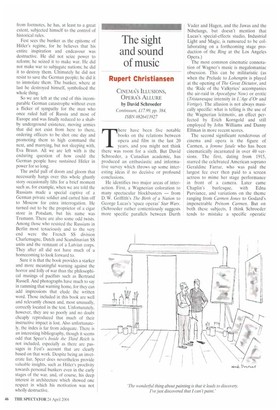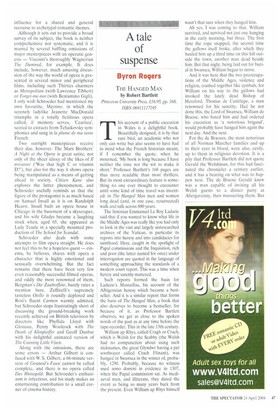The sight and sound of music
Rupert Christiansen
CINEMA'S ILLUSIONS,
OPERA'S ALLURE by David Schroeder Continuum, £17.99, pp. 384, ISBN 0826413927 There have been five notable books on the relations between opera and film in the last 20 years, and you might not think there was room for a sixth. But David Schroeder, a Canadian academic, has produced an enthusiastic and informative survey which throws up some interesting ideas if no decisive or profound conclusions.
He identifies two major areas of interaction. First, a Wagnerian coloration to many spectacular blockbusters — from D. W. Griffith's The Birth of a Nation to George Lucas's 'space operas' Star Wars. (Schroeder rather contentiously suggests more specific parallels between Darth Vader and Hagen, and the Jawas and the Nibelungs, but doesn't mention that Lucas's special-effects studio, Industrial Light and Magic, is rumoured to be collaborating on a forthcoming stage production of the Ring at the Los Angeles Opera.) The most common cinematic connotation of Wagner's music is megalomaniac obsession. This can be militaristic (as when the Prelude to Lohengrin is played at the opening of The Great Dictator, and the 'Ride of the Valkyries' accompanies the air-raid in Apocalypse Now) or erotic (Tristanesque intensity in L'Age d'Or and Vertigo). The allusion is not always musically specific: what is telling is the use of the Wagnerian leitmotiv, an effect perfected by Erich Korngold and still employed by John Williams and Danny Elfman in more recent scores.
The second significant rendezvous of cinema and opera is the figure of Carmen, a femme fatale who has been cinematically incarnated in over 40 versions. The first, dating from 1915, starred the celebrated American soprano Geraldine Farrar, who was paid the largest fee ever then paid to a screen actress to mime her stage performance in front of a camera. Later came Chaplin's burlesque, with Edna Purviance, and variations on the theme ranging from Carmen Jones to Godard's impenetrable Prenom Carmen. But on both these subjects, I think Schroeder tends to mistake a specific operatic
influence for a shared and general recourse to archetypal romantic themes.
Although it sets out to provide a broad survey of its subject, the book is neither comprehensive nor systematic, and it is marred by several baffling omissions of major masterpieces with an operatic genesis — Visconti's thoroughly Wagnerian The Damned, for example. It does include, however, much amusing discussion of the way the world of opera is presented in several minor and peripheral films, including such Thirties charmers as Metropolitan (with Lawrence Tibbett) or Forget-me-not (with Benjamin° Gigli). I only wish Schroeder had mentioned my own favourite„Waytime, in which the serenely ladylike Jeanette MacDonald triumphs in a totally fictitious opera called, if memory serves, 'Czaritza', scored to extracts from Tchaikovsky symphonies and sung in la plume de ma tante French.
Two outright masterpieces receive their due, however. The Marx Brothers' A Night at the Opera is great satire, not only of the sheer idiocy of the likes of II trovatore ('Was that high C or vitamin DT), but also for the way it shows opera being manipulated as a means of getting ahead in society. Citizen Kane also explores the latter phenomenon, and Schroeder usefully reminds us that the figure of the protagonist is as much based on Samuel Insull as it is on Randolph Hearst. Insull built an opera house in Chicago in the basement of a skyscraper, and his wife Gladys became a laughing stock when, aged 65, she appeared as Lady Teazle in a specially mounted production of The School for Scandal.
Schroeder also deals with some attempts to film opera straight. He does not feel this to be a hopeless quest — cinema, he believes, shares with opera a character that is highly emotional and sensually overwhelming. But the fact remains that there have been very few even reasonably successful filmed operas, and oddly the most renowned of them, Bergman's Die Zauberfl6te, barely rates a mention here. Zeffirelli's supremely tasteless Otello is roundly deplored and Rosi's fluent Carmen warmly admired, but Schroeder stops frustratingly short of discussing the ground-breaking work recently achieved on British television by directors like Phyllida Lloyd with Gloriana, Penny Woolcock with The Death of Klingh offer and Geoff Dunbar with his delightful animated version of The Cunning Little Vixen.
Along with the omissions, there are some errors — Arthur Gilbert is confused with W. S. Gilbert, a 66-minute version of Gounod's Faust cannot be called complete, and there is no opera called Das Rhinegold. But Schroeder's enthusiasm is infectious, and his study makes an entertaining contribution to a small corner of cinema history.



















































































 Previous page
Previous page